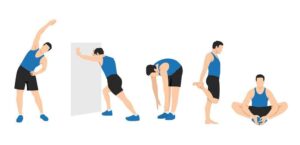Yoga exercises are an ancient practice for balance, flexibility, and inner peace. It’s also great for stress relief. Nowadays, it’s essential to unwind and relax in our fast-paced world. Yoga focuses on breath, movement, and mindfulness, which makes it a perfect way to relax. In this blog, we discuss the link between yoga and stress relief. We’ll provide some simple yoga poses and sequences you can do at home to help you feel calm and relaxed.
Understanding the Connection Between Yoga and Stress Relief
Yoga exercise has been found to profoundly impact stress reduction, as it helps calm the nervous system and promote relaxation. Engaging in yoga poses, also known as asanas, can decrease anxiety levels and improve the overall quality of life. One of the reasons yoga is so effective at reducing stress is its focus on breathing. The deep, rhythmic breaths that are a core part of yoga practice help activate the body’s relaxation response, reducing the production of stress hormones and promoting a sense of calm.
The Role of Yoga in Stress Management
Yoga serves as a powerful tool for managing stress and promoting overall well-being. By embracing yoga as an effective practice for reducing stress, you can enhance your mental clarity and emotional resilience. Yoga offers a holistic approach to alleviating stress, combining physical movement, breath awareness, and meditation. Yoga exercises can help cultivate inner balance, reduce stress, and nourish your body, mind, and spirit through regular practice.
Starting Your Journey with Basic Yoga Poses

Now that we understand the profound impact of yoga on stress relief let’s explore some basic yoga poses that are great for beginners. These poses are accessible to yogis of all levels and can be practiced at home with a yoga mat and some comfortable clothing. Remember, yoga is not about perfection but finding balance, strength, and relaxation in your body. So, let’s dive into some beginner-friendly yoga poses to help you start your yoga journey on the right foot.
-
Mountain Pose (Tadasana)
Mountain pose, or Tadasana, is a foundational pose in yoga practice. It may seem simple, but it offers a great way to cultivate proper alignment, balance, and grounding. To practice mountain pose, stand tall with your feet hip-width apart, toes pointing forward, and arms relaxed by your sides. Engage your leg muscles, press your feet into the mat, and lift through the crown of your head. Breathe deeply, feeling the earth’s energy supporting you as you find stillness and stability in this pose.
-
Chair Pose (Utkatasana)
Chair pose, or Utkatasana, is a great way to build stamina and lower body strength. From mountain pose, inhale as you reach your arms overhead, palms facing each other. Exhale as you bend your knees and lower your hips as if sitting back in an imaginary chair. Keep your weight in your heels, engage your core, and lengthen through your spine. Hold this pose for several breaths, feeling the burn in your thighs as you build strength and balance.
-
Tree Pose (Vrksasana)
Tree pose, also known as Vrksasana, is a standing balance pose that improves balance, stability, and focus. Start by standing tall in mountain pose, then shift your weight onto your left foot. Place the sole of your right foot against your left inner thigh, with toes pointing towards the mat. Find balance and stability, bring your hands to prayer in front of your heart, or reach them overhead for an extra challenge. Take deep breaths as you find a balance between ease and effort.
Intermediate Yoga Poses for Enhanced Relaxation
Now that you have mastered some basic yoga poses let’s move on to intermediate poses that will take your practice to the next level of relaxation and stress relief. These poses require more strength and flexibility, but with practice, you will find that they offer even greater benefits for your body and mind.
-
Warrior II (Virabhadrasana II)
Warrior II pose, or Virabhadrasana II is a standing pose that builds strength in the legs, arms, and core. From an upright position, step your left foot back about 3-4 feet, with your left foot turned out slightly and your right foot pointing forward. Bend your right knee, keeping it aligned with your right ankle, and extend your arms to the sides, parallel to the mat. Gaze over your right hand, finding strength and determination as you hold this pose. In yoga, the Warrior II promotes focus, balance, and a sense of empowerment.
-
Triangle Pose (Trikonasana)
Triangle pose, or Trikonasana, is a standing pose that stretches the hamstrings, hips, and spine, promoting flexibility. From the Warrior II pose, straighten your right leg as you reach your right hand forward, placing it on your right shin, ankle, or the mat as you lower your torso. Create a straight line from your left hand to your left foot by extending your left arm toward the ceiling. You should feel a sense of expansion in this pose as you extend and lengthen your torso.
-
Bridge Pose (Setu Bandha Sarvangasana)
Bridge pose, or Setu Bandha Sarvangasana, is a backbend pose that strengthens the back, glutes, and hamstrings while promoting relaxation. You should lie on your back with your knees bent, feet hip-width apart, and arms relaxed by your sides. Press your feet into the mat as you lift your hips off the mat, creating a bridge shape with your body. Engage your glutes, thighs, and core as you lower your shoulder blades down towards each other, opening your chest.
Stress-relieving exercises for individuals

I understand that you’re looking for yoga exercises to relieve stress. Yoga exercises are a powerful tool for relaxation and rejuvenation, and incorporating these personal exercises into your practice can be beneficial in finding inner peace. Here are my exercises that can help alleviate stress:
Child’s Pose (Balasana):
Kneel on the floor and bend forward, resting your forehead on the mat or a stack of pillows. You can either extend your arms in front of you or rest them alongside your body. This pose promotes deep relaxation and releases back neck, and shoulder tension.
Corpse Pose (Savasana):
You should lie flat on your back with your legs extended and your arms relaxed at your sides. Breathe deeply and slowly while closing your eyes. Allow yourself to completely let go and surrender to the stillness of this pose. Savasana is a powerful exercise for calming the mind, reducing anxiety, and promoting overall relaxation.
Legs Up the Wall Pose (Viparita Karani):
Find a clear wall space and lie on your back with your legs extended vertically against the wall. You can use a folded blanket or bolster under your hips for support. Imagine a gentle stretch in the back of your legs as you breathe deeply and feel grounded and stable. This pose helps to relieve tension in the legs, improve circulation, and promote relaxation in your body and mind.
Cat-Cow Pose (Marjariasana-Bitilasana):
Begin on all fours with your hands directly under your shoulders and knees under your hips—Inhale, arching your back and lifting your chest towards the ceiling, creating a gentle curve. Exhale, rounding your spine and lowering your head towards the floor. Your breath should be synchronized with this flowing motion. This pose helps to release tension in the spine and promote flexibility.
Standing Forward Bend (Uttanasana):
Place your hands on your hips and stand with your feet hip-width apart. Exhale and fold forward from the hips, keeping your spine elongated. Rest your hands on the floor or grab hold of opposite elbows. Release any tension in your hamstrings and lower back with the weight of your upper body. Feel a gentle stretch in the back of your legs and a sense of grounding as you take slow, deep breaths.
Safety Measures while Practicing Yoga
While yoga exercise offers numerous benefits, it’s important to prioritize safety and practice yoga mindfully, respecting your body’s limitations and boundaries. Here are some safety measures to keep in mind as you engage in yoga practice:
- Ensure proper alignment and posture in each pose, listening to your body and adjusting as needed.
- Use props, such as yoga blocks or straps, to support your body and practice yoga safely.
- Modify poses as necessary to accommodate any injuries, limitations, or physical conditions you may have.
- Honor your body’s needs and boundaries, never pushing yourself into poses that feel painful or uncomfortable.
- Remember that yoga is a self-care practice; practicing mindfulness, patience, and respect for your body is important.
Conclusion
To conclude, incorporating yoga exercises into your daily routine can be a transformative experience for stress relief. Whether you are a beginner or have been practicing for years, some poses and sequences can help you find calm and relaxation. From basic poses like Mountain Pose and Chair Pose to intermediate poses like Warrior II and Triangle Pose, each asana offers unique benefits in releasing tension and promoting well-being.